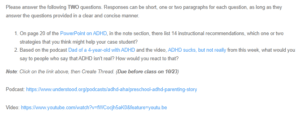Challenges Faced by Students with ADHD and Raising Awareness about ADHD
Instructional Recommendations that Might Help Students with ADHD
Students with ADHD face challenges remembering directions, but certain teaching strategies can help these learners thrive in the classroom. Some of the instructional strategies that can help my case student include combining visual and tactile cues with spoken instructions since integrating various modes of education is more successful in retaining attention and enhancing learning (Gargiulo & Bouck, 2021). Combining visual and tactile cues can significantly improve the remembrance, retrieval, and concentration levels of children with ADHD. This is because visual cues like images and tactile cues help students with ADHD to be more engaged with concepts and ideas in multiple ways, opening their world of possibilities as they engage with learning materials. Another strategy that could be applied is dividing assignments into manageable chunks and providing instantaneous feedback on each of the tasks (Gargiulo & Bouck, 2021). Instantaneous feedback may include praising a child for their efforts, which motivates the child, boosts their confidence, and makes learning more active and less passive. Moreover, the teacher should give these students more time to complete a task whenever necessary, as this gives children with ADHD room to succeed in the same ways and get the same rewards as students without the condition.
What I Would Say to People Who Say ADHD Isn’t Real
I will respond to them politely and raise awareness that ADHD exists just like any other disorder. I would let them know that people have brain differences due to different biological makeup, hence making others hyperactive. Moreover, human beings are wired differently, which makes some develop a disorder known as ADHD. ADHD is hereditary, and it makes the brain development of children with this condition vary from that of other children (Hinshaw & Ellison, 2015). In such a situation, I would also let those questioning know that there is scientific proof that this condition exists as, according to a report by the CDC in 2011, 11% of children aged 4 to 17 were diagnosed with ADHD (TED, 2015). Furthermore, it is important to create awareness that some ADHD symptoms interfere with a child’s ability to follow instructions like other learners. However, any child with the condition can be clinically diagnosed and treated.
References.
Gargiulo, R. M., & Bouck, E. C. (2021). Special education in contemporary society: An introduction to exceptionality (7th ed.). SAGE Publications, Inc.
Hinshaw, S. P., & Ellison, K. (2015). ADHD: What Everyone Needs to Know. Oxford University Press.
TED. (2015, December 18). ADHD sucks, but not really [Video]. YouTube. https://www.youtube.com/watch?v=fWCocjh5aK0&ab_channel=TEDxTalks
ORDER A PLAGIARISM-FREE PAPER HERE
We’ll write everything from scratch
Question

Challenges Faced by Students with ADHD
Please answer the following TWO questions. Responses can be short, one or two paragraphs for each question, as long as they answer the questions provided in a clear and concise manner.
- On page 20 of the PowerPoint on ADHD, in the note section, there list 14 instructional recommendations, which one or two strategies that you think might help your case student?
- Based on the podcast Dad of a 4-year-old with ADHD and the video, ADHD sucks, but not really from this week, what would you say to people who say that ADHD isn’t real? How would you react to that?
Note: Click on the link above, then Create Thread. (Due before class on 10/23)
Podcast: https://www.understood.org/podcasts/adhd-aha/preschool-adhd-parenting-story
Video: https://www.youtube.com/watch?v=fWCocjh5aK0&feature=youtu.be

